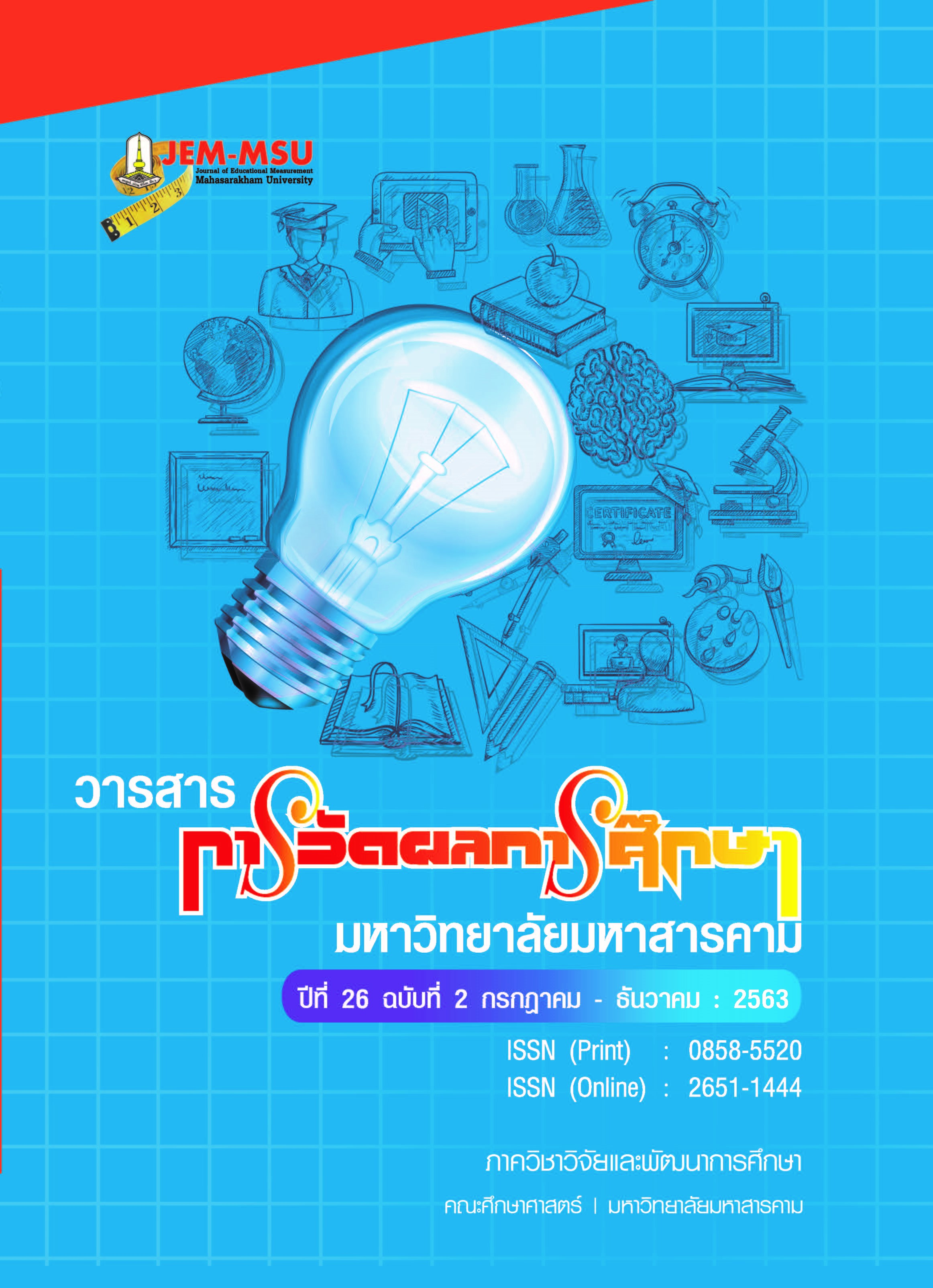Factors Affecting Continuing to Study in Vocational Education and Guidelines on Promoting the Image of Vocational Education: Mixed Methods Research
Main Article Content
Abstract
The research objectives were: 1) to study factors affecting continuing to study in vocational education; 2) to study guidelines on promoting the image of vocational education. The research was divided into three phases. Phase 1 was the study of qualitative data by interviewing 15 grade 10 students and 15 first year students of the certificate of vocational education class in order to collect data and develop the research instrument. Phase 2 was the study of quantitative data by inquiring 330 students from the certificate of vocational education level in the Inspection Area 13 about factors affecting their choice of continuing to study in vocational education. Phase 3 was the study of guidelines on promoting the image of vocational education by interviewing 4 administrators and teachers of vocational colleges. The research instruments were an interview form and a questionnaire. Data were analyzed using percentage, the mean and standard deviation.
The findings were as follows:
1. The factors that influenced the Inspection Area 13 students’ decision to choose to continue their education in vocational education comprised 8 aspects, having the overall mean at a high level ( = 4.19). Considered by aspect, the aspects are ranked in descending order as follows: the expense (
=4.46), interest in the career (
=4.33), influence of peer groups / seniors (
= 4.21), image and reputation of the institution (
= 4.15), expectations on the future career (
= 4.14), facilities, location and environment (
= 4.12), influence of the school / teachers (
= 4.09), and support from parents (
= 3.98), respectively.
2. The guidelines on promoting vocational education are listed as follows: (1) on the aspect of student development, the focus was on the production and development of quality manpower in vocational education, with the knowledge and skills required by the professional qualification framework, being able to compete in the labor market, both domestically and in the ASEAN region, and having virtues and ethics and desirable characteristics; (2) on the aspect of organizing for learning and teaching, the focus was on learner-centered learning and teaching for the students, local residents and people from other areas; in addition, curriculums and organizing for learning and teaching in vocational education must be consistent and must keep up with global trends; and (3) on the aspect of educational services, the focus was on professional services to the society by assigning students to provide services to people in the society and build relationships with them, in order to hone their confidence and skills. Improvement on public relations was carried out in order that it could be more accessible. Moreover, educational institution administration was developed by using the principles of good governance, with participation of the teacher and other personnel in raising ideas, guidelines on execution, management of conflicts, and boosting morale for everyone in the educational institution.
Article Details
The content and information contained in the published article in the Journal of Educational Measurement Mahasarakham University represent the opinions and responsibilities of the authors directly. The editorial board of the journal is not necessarily in agreement with or responsible for any of the content.
The articles, data, content, images, etc. that have been published in the Journal of Educational Measurement Mahasarakham University are copyrighted by the journal. If any individual or organization wishes to reproduce or perform any actions involving the entirety or any part of the content, they must obtain written permission from the Journal of Educational Measurement Mahasarakham University.
References
เกรียงศักดิ์ เจริญวงค์ศักดิ์. (2552). บทเรียนสหรัฐอเมริกา เปิดหลักสูตรสายอาชีพตามความต้องการตลาดแรงงาน. http://www.kriengsak.com/
ขวัญใจ เลอจันทร์. (2552). การเลื่อนฐานะทางสังคมของประชากร. วิทยานิพนธ์ ค.ม. กรุงเทพมหานคร : จุฬาลงกรณ์มหาวิทยาลัย.
ณัฐชา วัฒนวิไล และคณะ. (2552). ปัจจัยที่มีอิทธิพลต่อผลสัมฤทธิ์ทางการเรียนวิชาหลักการบัญชี: กรณีศึกษานักศึกษาคณะบัญชีมหาวิทยาลัยกรุงเทพ. http://www.bu.ac.th/knowledgecenter/ epaper/special_may2010/pdf/Page_121.pdf
ทวีชัย วิริยะโกศล. (2541). ปัจจัยที่ส่งผลต่อความคาดหวังทางการศกษาของนักเรียนชั้นมัธยมศึกษาปีที่ 3 เขตการศึกษา 1. วิทยานิพนธ์ ศึกษาศาสตรดุษฎีบัณฑิต สาขาบริหารการศึกษา, มหาวิทยาลัยมหิดล.
ทวีพันธ์ คล้ายเพ็ชร. (2541). แรงจูงใจของนักศึกษาที่เข้าศึกษาวิชาชีพระยะสั้นในวิทยาลัยสารพัดช่างเขตการศึกษา 5. วิทยานิพนธ์ครุศาสตร์อุตสาหกรรมมหาบัณฑิต. กรุงเทพฯ: สถาบันเทคโนโลยีพระจอมเกล้าเจ้าคุณทหารลาดกระบัง.
เทพ เหมือนฟู. (2542). การศึกษาปัจจัยที่มีผลต่อการตัดสินใจเลือกเรียนที่โรงเรียนอรรถวิทย์พาณิชยการ. วิทยานิพนธ์บริหารธุรกิจมหาบัณฑิต สาขาบริหารธุรกิจ : มหาวิทยาลัยเกษมบัณฑิต.
ไทยรัฐ. (2557). วิกฤติ! แรงงานขาดแคลน ทำไมเด็กเรียนอาชีวะน้อยลง?. http://www.thairath.co.th/content/42863
วรรณพร ปานภาค. (2553). ปัจจัยที่ส่งผลต่อการตัดสินใจเลือกสายอาชีวศึกษาของนักศึกษาระดับประกาศนียบัตรวิชาชีพ (ปวช.) ในเขตมีนบุรี กรุงเทพมหานคร . กรุงเทพฯ: มหาวิทยาลัยเกษตรศาสตร์.
วรัญญา เปรมฤทัย. (2545). การศึกษาปัจจัยที่ส่งผลต่อการตัดสินใจเข้าศึกษาต่อในโรงเรียนอาชีวศึกษาเอกชนในจังหวัดสมุทรปราการ. ปริญญานิพนธ์ ค.ม. กรุงเทพฯ : จุฬาลงกรณ์มหาวิทยาลัย.
วิทยากร เชียงกูล. (2553). รายงานสภาวะการศึกษาไทยปี 51 - 52. ชมรมศึกษาผลงาน. http://witayakornclub.wordpress.com.
วีรวัฒน์ พุ่มพยอม. (2541). การศึกษาแรงจูงใจเลือกสถานศึกษาเพื่อศึกษาต่อสายอาชีวศึกษาเอกชนระดับประกาศนียบัตรวิชาชีพ โรงเรียนเกษมโปลีเทคนิค. วิทยานิพนธ์ ปริญญามหาบัณฑิต บัณฑิตวิทยาลัย มหาวิทบยาลัยเกษมบัณฑิต.
ศิริลักษณ์ เรืองสารี. (2553). มูลเหตุจูงใจในการเข้าศึกษาต่อสายอาชีพของนักเรียนระดับประกาศนียบัตรวิชาชีพ (ปวช.) ชั้นปีที่1 ในโรงเรียนสายมิตรเทคโนโลยี. รายงานวิจัยแผนกช่างอุตสาหกรรมสาขาวชิาช่างไฟฟ้ากำลังโรงเรียนสายมิตรเทคโนโลยี.
สมบัติ สุวรรณพิทักษ์. (2553). ข่าวการศึกษา. ไทยรัฐออนไลน์. www.thairath.co.th
เสน่ห์ เสถียรพงศ์. (2540). การก่อเหตุทะเลาะวิวาททำร้ายร่างกายของนักเรียนอาชีวศึกษาในเขตกรุงเทพมหานครและปริมณฑล. วิทยานิพนธ์ ศศ.ม. กรุงเทพฯ: บัณฑิตวิทยาลัยมหาวิทยาลัยธรรมศาสตร์.
สำนักงานคณะกรรมการการอาชีวศึกษา. (2556). ระเบียบการวัดและประเมินผลหลักสูตรระดับประกาศนียบัตรวิชาชีพ. สำนักงานคณะกรรมการการอาชีวศึกษา. http://www.vec.go.th
สำนักงานเลขาธิการสภาการศึกษา. (2552). ข้อเสนอการปฏิรูปการศึกษาในทศวรรษที่สอง (พ.ศ.2552-2561). พิมพ์ครั้งที่ 2. กรุงเทพฯ: บริษัทพริกหวานกราฟฟิค จำกัด.
Yamane, Taro. (1973). Statiatics : An Introductory Analysis. London: John Weather Hill, Inc.


